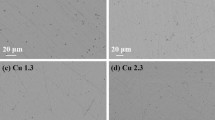Abstract
Methods of transmission and scanning electron microscopy and nuclear magnetic resonance (NMR) at 63Cu nuclei, as well as measurements of the static magnetic susceptibility χ(T) have been used to study a shape-memory alloy (SMA) Ti50Ni25Cu25, which experiences a thermoelastic martensite transformation. The alloy was obtained from an amorphous ribbon in a bimodal nano- and submicrocrystalline state via a crystallization annealing for 1 h at 770 K with a subsequent quenching to room-temperature water. The resultant B2 austenite is characterized by a fine structure of the 63Cu NMR spectra, which is connected with the different distribution of 63Cu atoms on the second coordination shell. The evolution of the shape of the spectra with decreasing temperature reveals a structural transition B2 → B19. In addition, the 63Cu NMR spectra, just as the transmission electron microscopy, indicate the presence of phase separation in the alloy, with the precipitation of a TiCu (B11) phase. The temperature dependence of the static magnetic susceptibility χ(T) also indicates the occurrence of a structural transition and has a hysteretic nature of “stepped” type. The discovered stepped nature of the χ(T) dependence is explained by the bimodal size distribution of grains of the B2 phase due to the size effect of the martensitic transformation.
Similar content being viewed by others
References
Yu. A. Izyumov and V. N. Syromyatnikov, Phase Transitions and Crystal Symmetry (Nauka, Moscow, 1984; Kluwer Academic, Dordrecht, 1990).
V. N. Khachin, V. G. Pushin, and V. V. Kondrat’ev, Titanium Nickelide: Structure and Properties (Nauka, Moscow, 1992) [in Russian].
K. Otsuka, K. Shimizu, Y. Suzuki, Y. Sekiguchi, C. Tadaki, T. Honma, and S. Miyazaki, Shape Memory Alloys, Ed. by H. Funakubo (Kyoto, 1984; Metallurgiya, Moscow, 1990).
V. G. Pushin, V. V. Kondrat’ev, and V. N. Khachin, Pretransition Phenomena and Martensitic Transformations (Ural. Otd. Ross. Akad. Nauk, Ekaterinburg, 1998) [in Russian].
V. N. Zhuravlev and V. G. Pushin, Alloys with Thermomechanical Memory and Their Application in Medicine (Ural. Otd. Ross. Akad. Nauk, Ekaterinburg, 2000) [in Russian].
V. G. Pushin, S. D. Prokoshkin, R. Z. Valiev, et al., Titanium Nickelide Shape Memory Alloys. Part I. Structure, Phase Transformations and Properties (Ural. Otd. Ross. Akad. Nauk, Ekaterinburg, 2006) [in Russian].
V. G. Pushin, “Alloys with a Thermomechanical Memory: Structure, Properties and Application,” Phys. Met. Metallogr. 90(Suppl. 1), S68–S95 (2000)].
V. G. Pushin, “Structures, Properties, and Application of Nanostructured Shape Memory Ti-Ni-Based Alloys,” in Nanomaterials by Severe Plastic Deformation, Ed. by M. Zehetbauer and R. Valiev (Wiley, Weinheim, 2004), pp. 822–828.
V. G. Pushin, S. B. Volkova, and N. M. Matveeva, “Structural and Phase Transformations in Quasi-Binary TiNi-TiCu Alloys Rapidly Quenched from the Melt: I. High-Copper Amorphous Alloys,” Fiz. Met. Metalloved. 83(3), 68–77 (1997) [Phys. Met. Metallogr. 83 (3), 275–282 (1997)].
V. G. Pushin, S. B. Volkova, and N. M. Matveeva, “Structural and Phase Transformations in Quasi-Binary TiNi-TiCu Alloys Rapidly Quenched from the Melt: II. Alloys with Mixed Amorphous-Crystalline Structure,” Fiz. Met. Metalloved. 83(3), 78–85 (1997) [Phys. Met. Metallogr. 83 (3), 283–288 (1997)].
B. A. Aleksashin, V. V. Kondrat’ev, K. A. Okulova, et al., “Pretransition Phenomena and Martensitic Transformation in Ti50Ni25Cu25 Alloy: NMR and Magnetic Susceptibility,” Fiz. Met. Metalloved. 89(1), 31–38 (2000) [Phys. Met. Metallogr. 89 (1), 27–34 (2000)].
B. A. Aleksashin, E. G. Gerasimov, V. V. Kondrat’ev, et al., “Pretransition Phenomena and Martensitic Transformation in the Ti50Ni25Cu25 Alloy with a Nanocrystalline Structure: NMR of 63Cu and Magnetic Susceptibility,” Fiz. Met. Metalloved. 95(3), 31–43 (2003) [Phys. Met. Metallogr. 95 (3), 225–236 (2003)].
Author information
Authors and Affiliations
Additional information
Original Russian Text © B.A. Aleksashin, V.V. Kondrat’ev, A.V. Korolev, A.V. Pushin, V.G. Pushin, A.V. Soloninin, A.P. Tankeyev, 2010, published in Fizika Metallov i Metallovedenie, 2010, Vol. 110, No. 6, pp. 608–613.
Rights and permissions
About this article
Cite this article
Aleksashin, B.A., Kondrat’ev, V.V., Korolev, A.V. et al. 63Cu NMR spectra, magnetic susceptibility, and transmission electron microscopy of the rapidly quenched alloy Ti50Ni25Cu25. Phys. Metals Metallogr. 110, 582–587 (2010). https://doi.org/10.1134/S0031918X10120094
Received:
Accepted:
Published:
Issue Date:
DOI: https://doi.org/10.1134/S0031918X10120094




